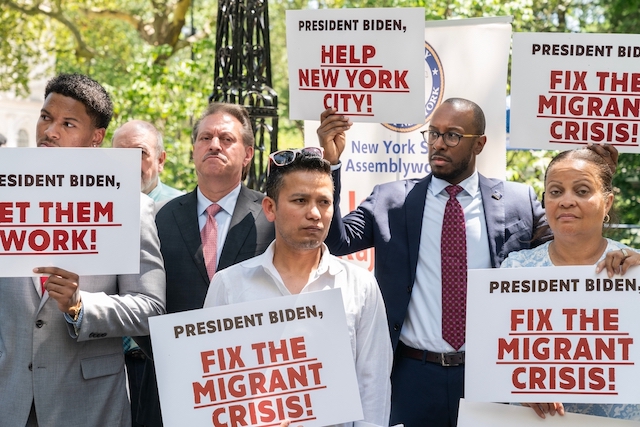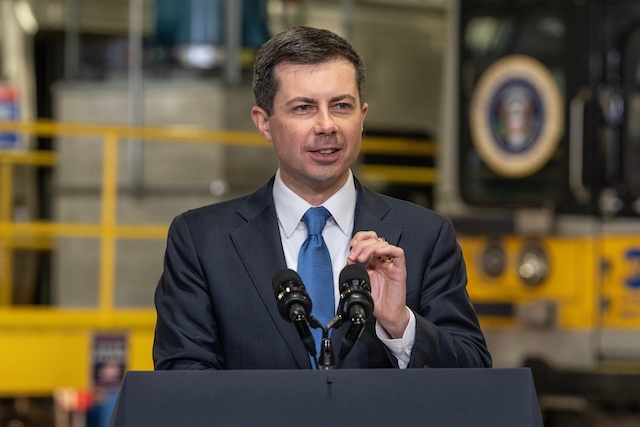As the curtain falls on 2023, a year marked by profound challenges and significant achievements, we reflect on the pivotal events that shaped New York City and the world. From the intense conflict in the Middle East to the transformative developments in the Big Apple, this review delves into the stories of resilience, innovation, and change that defined the year.
- Israel-Hamas War of 2023
- Migrant Crisis in NYC
- Transportation Evolution in NYC
- Local Law 97
- Expansion of the Life Sciences Sector
- Advancements in Sustainability
- Policy Changes in NYC
- Office-to-Residential Conversions
- Residential Estate Dynamics
- Retail, Office, Muti-Family Trends
- Predictions & Outlook for 2024

The Israel-Hamas War of 2023 marks a significant escalation in the longstanding conflict between Israel and Palestinian militants, predominantly Hamas and the Palestinian Islamic Jihad (PIJ). This war began on October 7, 2023, when Hamas launched a comprehensive attack from the Gaza Strip, leading to the deadliest day for Israel since its independence with over 1,200 deaths, primarily Israeli citizens.
Israel responded with air strikes on Gaza, followed by a ground invasion. This military action led to substantial Palestinian casualties, with reports suggesting that over 18,000 Palestinians, including more than 7,000 children, were killed. The high number of civilian casualties and the humanitarian crisis that ensued in Gaza have been subjects of global concern.
The roots of this conflict trace back to the establishment of the State of Israel in 1948 and the subsequent displacement of Palestinians, many of whom became refugees in the Gaza Strip. Historical events, including the Six-Day War of 1967, the Oslo Accords, and a series of clashes and ceasefires over the decades, have contributed to the complex dynamics of this conflict.
The October 7 attack by Hamas was reportedly a response to a range of issues, including the ongoing Israeli occupation of Palestinian territories and the blockade of the Gaza Strip. Political changes within Israel, regional dynamics, and international relations, such as the Israeli-Saudi-U.S. peace negotiations, also played a role in the backdrop of these hostilities.
Both Israel and Hamas have faced accusations of war crimes due to the scale of destruction and the loss of civilian life. The humanitarian situation in Gaza, exacerbated by the destruction of infrastructure and limitations on access to essential services, has drawn international attention and calls for a ceasefire and diplomatic resolution.
The Israel-Hamas War of 2023 significantly impacted New York City, stirring deep emotions and political responses across its diverse population. As home to the world’s largest Jewish population outside of Israel and significant Palestinian communities, the city experienced heightened tensions and involvement. New Yorkers with connections to the region were deeply affected, with some facing harassment and others actively participating in advocacy and demonstrations. Politically, the conflict revealed and intensified divisions within the Democratic Party, particularly between progressives and moderates. This reflects a broader debate over support for Israel or Palestine. The divide manifested in various rallies and public demonstrations, emphasizing the complexity of the issue within the city’s political and social fabric.
For more comprehensive and detailed coverage, refer to the following full articles: 2023 Israel–Hamas War; 2023 Israel–Hamas War.

In 2023, New York City faced a significant migrant crisis, with a dramatic influx of asylum seekers and immigrants, sparking both challenges and a humanitarian response.
This inflow presented unique demands on the city’s resources and infrastructure, requiring a concerted effort to provide aid, housing, and support services to those arriving in search of safety and opportunity. In response, New York City established the Roosevelt Hotel as a center for asylum seekers, aiding over 100,000 individuals.
However, the response was met with challenges due to limited support from state and federal levels, highlighting the nuances involved in addressing such a large-scale humanitarian issue. The city’s approach was multifaceted, focusing on immediate needs like shelter and food, as well as long-term solutions such as integration assistance and legal support.
The complexities of this response are highlighted through personal narratives of those affected, visible in detailed reports on The New York Times, and the operational aspects of the center depicted on NYC.GOV. For broader context, the International Organization for Migration’s World Migration Report and the Migration Policy Institute provides insights into global migration trends and potential future policy directions.

Transportation Evolution:
In 2023, New York City’s development of its transportation infrastructure was marked by significant federal funding, driving several key initiatives.
A major highlight, Phase 2 of the Second Avenue Subway Extension, supported by $3.4 billion in federal aid, aims to extend the Q line from 96th Street to 125th Street in East Harlem. This extension is expected to alleviate congestion and improve access in underserved areas.
This initiative is part of the larger Federal Fiscal Years 2023-2027 Transportation Improvement Program (TIP), prepared by the New York Metropolitan Transportation Council (NYMTC), which outlines various federally funded transportation projects. More details on the Second Avenue Subway Extension can be found in Governor Hochul’s announcement and on 6sqft.
Other transformative projects include the development of the Interborough Express light rail to connect underserved areas of Brooklyn and Queens Inter-borough Express Project , and the Gateway Project , involving new rail tunnels under the Hudson River Gateway Program .
Additionally, the expansion of Metro-North services in the Bronx is set to enhance access to Penn Station. More information available on the MTA’s project page
The Transportation Improvement Program (TIP) includes improvements across roadways, bridges, bicycle and pedestrian facilities, transit services, and safety programs. It adopts a systemic approach, focusing on the resilience of the surface transportation system against weather events and natural disasters. The visualization of these projects using ArcGIS Online , as presented on the NYMTC website, enhances public outreach and understanding of these improvements.
Collectively, these projects under the TIP, along with the Second Avenue Subway Extension, represent a significant investment in improving New York City’s transportation infrastructure, aiming to ensure safety, efficiency, and sustainability for the future.

Life Sciences Sector Expansion:
The expansion of the life sciences sector in New York City in 2023 represents significant growth, particularly in Manhattan and Long Island City. Mayor Eric Adams and the New York City Economic Development Corporation (NYCEDC) have made a notable investment of $26.6 million to support the growth of New York City’s life sciences industry.
This funding is part of the LifeSci NYC initiative, a $1 billion investment aiming to position New York City as a global leader in life sciences. The initiative focuses on creating new economic opportunities for New Yorkers and advancing healthcare and technology. Specifically, the investment includes $15 million awarded to the City College of New York (CCNY) and $11.6 million to the Mount Sinai Health System. These awards will support the construction of new facilities that will contribute to the creation of new life sciences startups in the city and promote innovation and talent development.
Notably, the Taystee Lab Building in West Harlem, where CCNY’s City Innovations Collaborative will be housed, is expected to catalyze over 1,400 life science jobs in Greater Harlem, support more than 275 fellows and interns, and lead to the creation and attraction of over 100 new life sciences ventures. Moreover, Mount Sinai will establish a medical device prototyping facility, one of the only such facilities in the nation embedded on a hospital campus. This facility will support startups, engineers, doctors, and surgeons in designing, testing, and commercializing new medical devices to improve patient care and outcomes.
The initiative also includes expanding the LifeSci NYC Internship program, forming a new Real Estate Life Sciences Advisory Board, and expanding the LifeSci NYC Advisory Council. These efforts are expected to support the exponential growth of the life sciences sector in New York City, resulting in job creation and economic growth.
For more detailed information on these developments, you can visit the City of New York’s official announcement.

In 2023, New York City’s commitment to sustainability was notably advanced through Local Law 97, part of the Climate Mobilization Act. This law sets a bold agenda for reducing greenhouse gas emissions from large buildings, targeting a 40% reduction by 2030 and 80% by 2050. Complementing this, the city’s sustainability strategy, “PLANYC: Getting Sustainability Done,” encompasses 32 initiatives aimed at fostering a greener urban environment, including expanding green spaces and promoting electric vehicle use.
Mayor Adams furthered these efforts with the “Getting 97 Done” plan, focusing on strategic initiatives to reduce carbon emissions in large buildings. This comprehensive approach to sustainability showcases New York City’s proactive stance in addressing environmental challenges. The law not only sets quantitative targets but also integrates a range of initiatives that touch upon various aspects of urban life, from infrastructure to daily living.
This multifaceted strategy is designed to transform the city into a model of urban sustainability, setting an example for cities worldwide.
For more detailed information about Local Law 97 and its implications for New York City, you can visit the NYC Sustainable Buildings page. Additionally, insights into the city’s transition to an environmentally sustainable economy can be found in a report from Columbia University’s State of the Planet and the Sustainable Building News.

In 2023, New York City’s advancements in sustainability, particularly in electrification and renewable energy, were marked by significant initiatives and investments. The city’s transition to a sustainable and cleaner energy model was highlighted by the launch of a $1.2 billion renewable energy fund by energyRe , aimed at enhancing renewable energy capacity with a focus on wind, solar, and energy storage projects.
This initiative is a key step in decarbonizing the city and developing advanced electric grids, as detailed on CleanTechnica. The New York State Energy Research and Development Authority (NYSERDA) also played a crucial role with its expedited renewable energy solicitations, part of Governor Hochul’s 10-Point Action Plan. These proposals, aligned with the Climate Leadership and Community Protection Act, aim to achieve 70% of New York’s electricity from renewable sources by 2030, and the development of 9,000 megawatts of offshore wind by 2035, as outlined on the NYSERDA website.
Moreover, Governor Hochul’s 2023 Budget includes a $500 million investment in offshore wind supply chain and port infrastructure, along with a plan to transition all school buses to zero emissions by 2035. This budget highlights the expansion of clean water, clean air, and green jobs initiatives, signifying a commitment to environmental protection and climate change resilience, as announced on Governor Hochul’s official page.
These concerted efforts in renewable energy and electrification showcase New York City’s dedication to sustainable urban development, positioning it as a leader in this arena.

Policy Changes:
- 1. Local Law 18 – The End of Airbnb in New York City:
Airbnb’s discontinuation of services in New York City in 2023 marks a significant policy change, greatly impacting short-term rental platforms, hosts, and guests. New York City implemented stringent regulations on short-term rental platforms. The new rules, which took effect in September, require hosts to register their rentals with the city and restrict listings to two or fewer guests for stays under 30 days. Hosts must also be present during the guests’ stay. This move, essentially a “de facto ban” on Airbnb, led to a dramatic reduction in listings, from 22,000 to fewer than 7,000 in a short span.
Airbnb responded with a lawsuit against the city, arguing that the new law is overly restrictive and has led to a significant decrease in hosts participating in the short-term rental market. In 2021, a similar law prompted 29,000 hosts to leave the market. As of April 2023, short-term rental listings in New York City had increased by 27% year-over-year but were still 32% below 2019 levels. The city administration, under Mayor Eric Adams, has emphasized that these measures aim to protect residents’ safety and community livability, preserve permanent housing stock, and ensure the recovery and thriving of the hospitality sector.
These policy changes have far-reaching implications. They impact not only Airbnb hosts, who relied on rental income, but also the dynamics of specific neighborhoods and the broader housing market in New York City. While some argue that the law may help alleviate the housing crisis by returning units to long-term housing, others believe the impact on overall housing prices will be minimal due to the city’s large scale Local Law 18 – NYC Airbnb Ban on Wired.
- 2. Accessory Dwelling Units (ADUs) program:
In 2023, New York City embarked on an ambitious journey to address its housing challenges with the introduction of a pioneering Accessory Dwelling Units (ADUs) program by the Department of Housing Preservation and Development (HPD). This program, backed by $2.6 million in state funding, is a transformative step in creating additional affordable housing options in the city.
Homeowners are incentivized to create ADUs in basements, backyards, or garages, with the program offering up to $395,000 in construction and design assistance for projects in up to 15 single-family homes. This initiative is a critical component of Mayor Eric Adams’s “City of Yes for Housing Opportunity” package, a comprehensive plan to address New York City’s housing crisis. For further details on the ADU program NYC Department of Housing Preservation.
- 3. City of Yes for Housing Opportunity
The “City of Yes” initiative aims to tackle zoning challenges and add 500,000 new homes over the next decade, with a significant portion – 100,000 units – anticipated to arise from zoning changes. This approach signifies a shift in urban policy, focusing on flexibility, inclusivity, and the utilization of existing spaces to meet the city’s housing needs.
Mayor Adams’s “City of Yes for Housing Opportunity” reflects an innovative approach to urban development, aiming to create a more inclusive, adaptable, and sustainable housing landscape in New York City Mayor Adams Launches Historic Effort To Build A Little more Housing In Every Neighborhood.
- 4. Intro 195:
In 2023, the New York City Council addressed a crucial aspect of the city’s housing market by passing a bill focused on the warehousing of vacant rent-regulated apartments. This legislative action, known as Intro 195, was a response to the high number of vacant apartments and the broader housing affordability crisis. The bill enables tenants to report vacant units that may pose hazards, allowing city officials to inspect these units for issues like mold, open windows, or rodent infestations. This initiative, as reported by THE CITY and W42St signifies a significant move towards enhancing tenant rights and addressing apartment maintenance.
The bill has faced criticism from landlord groups who argue that it doesn’t address the underlying financial challenges of maintaining rent-stabilized units, as detailed in The Real Deal. They contend that restrictions on rent increases make it financially unviable to repair and re-rent these apartments. Landlords’ perspectives, including their criticism of the bill as a wasteful effort, is also covered in The Real Deal.
- 5. Community Housing Improvement Program (CHIP):
The Community Housing Improvement Program (CHIP) proposed the Local Regulated Housing Restoration Adjustment (LRHRA), which aims to allow a one-time rent reset for stabilized units upon tenant vacancy. This policy is intended to make it financially feasible for landlords to repair and re-rent these units. However, this proposal has faced opposition from legislators concerned about eroding tenant protections, a concern also reported by The Real Deal
These series of policy developments in New York City reflects the complex challenges in balancing tenant rights, housing affordability, and the financial viability of maintaining rent-stabilized housing stock. The City Council’s bill is a step towards empowering tenants and ensuring the maintenance of vacant units, while the debate continues over the best approach to sustainably manage the city’s rent-regulated housing.
Expansion of Housing Voucher System and Amendments to Criminal Background Check Policies:
In 2023, New York City Council passed significant legislation to address the housing crisis and reform the City’s rental assistance voucher program, CityFHEPS (City Family Homelessness and Eviction Prevention SupplementCity Family Homelessness and Eviction Prevention Supplement). The Council’s efforts primarily focused on expanding the housing voucher system and amending policies related to criminal background checks for housing applicants.
These changes are part of a broader initiative to assist those facing homelessness or eviction and to improve access to affordable housing in the city.
- 6. Expansion of the Housing Voucher Program:
The City Council’s expansion of the housing voucher system aimed to provide more assistance to individuals and families at risk of homelessness or eviction. This expansion is crucial, considering New York City’s severe housing shortage, with less than 1 percent of apartments with rents below $1,500 currently available for new tenants. In fiscal year 2023, the Department of Social Services (DSS) helped 15,000 households move out of shelters into permanent housing, an increase of approximately 18 percent over the previous year. The expansion allows CityFHEPS voucher holders to identify and obtain housing outside of the five boroughs, thereby offering them greater flexibility and aligning the CityFHEPS voucher program more closely with the federal Section 8 voucher program.
- 7. Amendments to Criminal Background Check Policies in NYC Housing:
In a significant move towards housing equity, the New York City Council approved the “Fair Chance for Housing Act” (Intro. 632-A) with a decisive 39-8 vote. This groundbreaking act, set to become effective on January 1, 2025, places restrictions on landlords’ ability to conduct criminal background checks on potential tenants. According to this new legislation, led by Council Member Keith Powers, criminal history can only be considered after other qualifications of an applicant have been evaluated.
The Fair Chance for Housing Act allows landlords to consider misdemeanors and felonies committed within the last three to five years, respectively, as well as registered sex offenses. However, it mandates that landlords must provide written justification if an applicant is rejected based on their criminal history. This act reflects the principles of the Clean Slate Act, demonstrating a commitment to easing access to housing, jobs, and education for individuals with criminal records, thereby fostering a more inclusive community.
It’s important to note that the bill does have its exclusions. It does not apply to two-family owner-occupied housing and cases where criminal background checks are mandated by federal, state, or local laws. This new policy marks a significant shift in housing policy in New York City, highlighting the city’s dedication to offering a fair chance to all individuals, regardless of their past, in securing housing.
These policy changes are expected to have significant positive impacts on vulnerable populations in New York City. They are designed to provide more New Yorkers with the opportunity to secure stable and affordable housing. However, there are various perspectives on these changes. While some see these reforms as crucial steps toward addressing the housing crisis and homelessness in New York City, others may raise concerns about the financial implications and the effectiveness of these measures in the long term.
For more in-depth insights into these housing policy changes, you can explore further through the following sources: announcement on CityFHEPS ; Community Service Society of New York’s overview of CityFHEPS; Governor Hochul Expands Economic Opportunity for New Yorkers, Protects Public Safety by Signing the Clean Slate Act ; City Council passes bill to limit landlords from running criminal background checks on prospective tenants
2023 also saw significant policy changes in real estate disclosures in New York City, particularly concerning flood risks and property conditions. These changes were driven by two key legislative actions aimed at enhancing transparency and safeguarding homebuyers and renters.
- 1. Firstly, Governor Hochul signed a bill amending the Property Condition Disclosure Act (PCDA) on September 22, 2023. This amendment, effective March 20, 2024, introduces substantial changes to the Property Condition Disclosure Statement (PCDS). The amendment to the PCDA eliminates the seller’s option to offer a $500 credit instead of providing a PCDS. It also adds seven new questions related to flooding, such as whether the property is in a FEMA flood zone, requirements for flood insurance, and any flood damage claims. This change essentially revokes the traditional rule of caveat emptor (buyer beware) in New York real estate transactions, placing more responsibility on sellers to disclose information about residential properties Environmental Law by Schnapf LLC.
- 2. Additionally, the State Legislature passed a historic flood risk disclosure law on June 9, 2023. This legislation requires home sellers to disclose the history of flooding on the property and the likelihood of future floods to potential buyers. The bill addresses a loophole that previously allowed sellers to avoid disclosing flood history by paying a $500 credit at the time of sale. This new law enhances the State’s existing PCDS by including additional questions related to flood risk. The law aims to provide essential flood history and risk information to homebuyers, helping them make better-informed decisions regarding properties in flood-prone areas Waterfront Alliance.
* These legislative changes represent a significant shift in New York’s approach to real estate disclosures, emphasizing the need for greater transparency and accountability in property transactions, especially in the context of increasing climate change impacts and flood risks.
For more detailed information, you can explore the following sources:

Broker Fee Legislation and Lawsuits:
The New York City real estate landscape is currently navigating through a period of significant legal and regulatory changes, primarily highlighted by the broker fee legislation and buyer agent compensation lawsuits.
- Broker Fee Legislation:
Spearheaded by NYC Council member Chi Ossé, the Fairness in Apartment Rental Expenses Act proposes shifting the broker fee burden from tenants to landlords. This legislative change aims to align NYC with other major cities where the hiring party pays the broker fee, a deviation from the city’s norm where tenants often bear these costs. The proposal has met substantial resistance, particularly from the Real Estate Board of New York (REBNY). They argue that such a shift could lead to increased rental costs, as landlords might pass the additional expenses onto tenants. Despite opposition, the bill has gained support from various council members, highlighting the nuanced debate over rental costs in the city News 12 Brooklyn; The Real Deal.
- Buyer Agent Compensation Lawsuits:
These developments in broker fee legislation and buyer agent compensation lawsuits reflect a transformative phase in New York City’s real estate sector. The outcomes of these legislative and legal proceedings are likely to have a lasting impact on how real estate transactions are conducted in one of the world’s most dynamic real estate markets.
The Market in 2023:
The New York City real estate market in 2023 is characterized by several key trends and dynamics that paint a complex picture of the housing landscape.
- Market Overview: As of October 2023, the median listing home price in NYC is $1.1 million, marking a 37.67% year-over-year increase. The median home sold for $705K, with properties typically selling for about 97.14% of their listing price. This indicates some room for negotiation in transactions. Properties are selling relatively swiftly, staying on the market for an average of 73 days, reflecting a lively market despite its complexity and size.
- Market Predictions and Trends: Despite a general cooling in buyer demand due to higher mortgage rates, a significant decline in NYC home prices is not expected. Many sellers are hesitant to enter the market, maintaining pressure on the still-limited inventory. The rental market is expected to see a slight dip in rents, though the process will be gradual due to the limited number of rental units. Moreover, NYC homeowners are better prepared for a possible recession, given the positive equity most of them have in their homes 2024 NYC Housing Market Predictions.
For more information and insights, you can explore the following sources: NYC Real Estate Market; NYC Market Reports; Other Resources - Luxury Residential Market:
The New York City luxury real estate market in 2023 encountered a mix of challenges and transformations. After a strong close to 2022 with luxury home sales totaling $10.3 billion, the 2023 market contended with potential economic challenges such as recession fears, rising interest rates, and inflation. These factors had a marked influence on the high-end market affecting buyer behavior and overall market dynamics.
In July 2023, the luxury market in Manhattan, notably in the ultra-high-end category of $20 million and above, experienced an 11.5% year-over-year increase in median asking prices, reaching $7.75 million. This rise was largely propelled by affluent buyers investing in new construction condos, with a particular focus on Midtown Manhattan.
Concurrently, the overall median asking price for Manhattan real estate ascended to $1.595 million, the highest since December 2019. This trend reinforced a vigorous and competitive market landscape, where sellers of high-end properties maintained leverage due to a scarcity of new listings and limited inventory.
The luxury market also saw evolving trends, with a shift in buyer preferences post-pandemic towards properties featuring community-oriented amenities.
Additionally, the market witnessed the emergence of unique trends such as luxury bunkers and the increasing popularity of upscale short-term rental properties.
For those looking to enter the luxury market, strategies included purchasing in more affordable neighborhoods or opting for fixer-uppers to later infuse with luxury elements. This approach allowed buyers to navigate the market more strategically, considering various factors including board approvals and renovation permits.
Overall, the NYC luxury real estate market in 2023 presented a complex yet dynamic environment, with economic factors, evolving preferences, and unique market dynamics significantly influencing sales, particularly in the ultra-luxury segment.
To understand the pricing dynamics and trends in the Manhattan luxury market, check out:
Manhattan Residential Properties $4 Million and Above;Mansion Global; Sales of N.Y.C. Homes Worth $20 Million and Above Have Surged 300% This Year
Neighborhood Variations:
As of October 2023, the real estate market in New York City shows significant variation across different neighborhoods. Specifically, Tribeca and Rego Park stand out as examples of the extremes in the housing market:
Tribeca, known for its affluent status and prime location, has one of the highest median listing home prices in New York City. As per a report from Realtor.com, the median listing home price in Tribeca was $4.9 million in October 2023 TriBeCa Real Estate Market Trends ; Rego Park Real Estate Market Trends . This figure positions Tribeca as one of the most expensive neighborhoods in the city, reflecting its high-end real estate market.
On the other end of the spectrum is Rego Park. Located in Queens, Rego Park offers a more affordable housing market compared to neighborhoods like Tribeca and is generally known for its more modestly priced housing options. In the context of New York City’s diverse real estate landscape, Rego Park emerges as one of the more accessible neighborhoods for a broader range of buyers.
These neighborhood variations highlight the diversity of the New York City real estate market. Factors such as location, local amenities, and the type of housing available play significant roles in determining the pricing trends in each neighborhood. Tribeca, with its luxury apartments, proximity to financial and cultural centers, and historical significance, commands premium pricing. In contrast, neighborhoods like Rego Park offer more affordable options, often appealing to first-time homebuyers or those seeking value in a city known for its high cost of living.
Residential Rental Trends:
The rental market in New York City (NYC) has experienced significant fluctuations in 2023, leading to a complex scenario heading into 2024.
- Rental Growth and Peak Rates:
In early 2023, NYC witnessed a significant rental boom, with annual growth rates peaking at nearly 40% in the first quarter. However, this growth has since slowed considerably, with the annual rate dropping to 2.4% and rents declining by 1.3% over the past three months. This deceleration is attributed to both an increase in new supply and the limited ability of tenants to pay higher rents due to slower wage growth The great New York rental boom of 2023.
- Manhattan Market Dynamics:
In Manhattan, the median rent for new leases has shown a decline, which was more pronounced than in other boroughs. This decline marks the first annual drop in median rent in Manhattan in 27 months. Despite this decrease, the rental market has not matched the pace of the significant rent increases seen in the previous year. The inventory in Manhattan has increased, leading to heightened competition among landlords, thereby discouraging them from raising rents What’s happening with the NYC rental market?.
- Brooklyn’s Persisting High Rents:
In Brooklyn, despite an 8.9% increase in rental inventory compared to the previous year, the area has seen fewer listings than pre-pandemic levels, maintaining strong rent increases. However, there is an expectation of more relief for renters in Brooklyn in 2024, with more rental concessions likely to be offered due to elevated rents and high mortgage rates StreetEasy.
- Queens Defying the Trend:
Queens stands out as the borough where rent growth has not slowed. The median asking rent increased significantly over the year, driven by strong demand that outpaced the rise in inventory. This high demand has kept rental concessions relatively low compared to other boroughs Rental price growth in NYC slows for first time since pandemic: report – QNS.com.
Overall Rise in Median Rents:
Across the five boroughs of NYC, median asking rents rose by 9.3% in 2023, though this increase was less steep compared to the previous year. This trend indicates a slowing in the rate of rent increases compared to the dramatic rises seen earlier Median asking rents in NYC rose 9.3% this year, report finds.
In 2024, Manhattan is expected to become more attractive to renters as asking rents decline from their peak in 2023. The increased competition among landlords in Manhattan will likely lead to more concessions and a dip in asking rents. In contrast, in Brooklyn and Queens, high mortgage rates and the continued interest in rentals could maintain a robust rental market in 2024.
Office-to-Residential Conversions:
In 2023, New York City’s real estate landscape witnessed a significant trend in converting underutilized commercial buildings into residential units, particularly in Manhattan. This movement, driven by the ongoing shift to remote work and low occupancy in Class B and C office buildings, has emerged as a novel solution to the city’s housing shortages.
- Key Developments and Influences:
The first half of 2023 saw an increase in the feasibility of such conversions, especially in areas like the Financial District. Initiatives like Silverstein Properties’ first office-to-apartment conversion in lower Manhattan highlighted this trend. The Vanbarton Group also made strides by transforming office space at 980 Sixth Avenue into residential rentals, reflecting a broader market adaptation.
- Challenges and Regulatory Landscape:
While offering a potential solution to housing needs, these conversions face challenges such as high costs and the need for compliance with housing regulations. Many converted units are positioned as luxury rentals, impacting affordability. Mayor Eric Adams proposed significant zoning changes to facilitate and encourage more housing construction, including easing the process for office-to-residential conversions, as part of a larger plan to build 100,000 homes over the next decade.
- Broader Implications:
This trend presents both challenges, including regulatory hurdles and suitability concerns, and opportunities, such as addressing housing shortages and potential environmental benefits. A report suggested considerable carbon savings from expanding office-to-residential conversion eligibility under the proposed zoning changes, highlighting the sustainability aspect.
Sources: What No One Tells Landlords About NYC Office-to-Residential Conversions – Commercial Observer; Office-to-housing conversions continue in the city; Vanbarton Group Converting NYC WeWork Office to Residential; 5BORO Institute Releases Proposal to Create More Affordable Homes Through Office-to-Residential Conversions; Mayor Adams Proposes Dramatic Zoning Changes to Boost Housing Construction – Commercial Observer; Converting Offices into Homes: A Possible Solution to Real Estate Challenges? – BNN Breaking ; Study estimates carbon savings from expanding office to residStudy estimates carbon savings from expanding office to residential conversion eligibility – Arup

In 2023, New York City’s retail market experienced a dynamic phase, balancing recovery with ongoing challenges. Luxury retail sales demonstrated robust growth, with projections indicating an increase from nearly $70 billion in 2022 to around $75 billion.
This upward trend was accompanied by significant leasing activity, with luxury retailers signing leases for a total of 650,000 square feet of space, signaling a period of dynamic expansion for the sector. Notably, luxury brands expanded beyond traditional hubs like Fifth Avenue and SoHo to include emerging neighborhoods such as Williamsburg, attracting top brands like Chanel and Hermès.
A key highlight of the year was Prada’s strategic acquisitions on Fifth Avenue. The Italian fashion house purchased two buildings, 720 and 724 Fifth Avenue, for a total of $835 million. This move signifies Prada’s investment in one of the world’s most prestigious retail corridors and reflects its confidence in the future of the luxury retail market in New York City. Additionally, Hermès’ Madison Avenue store significantly contributed to its sales after opening in October 2022, reflecting the strength of high-end retail in NYC.
Overall, the brick-and-mortar retail sector, driven by increased consumer confidence and a resurgence of tourists, witnessed a notable rebound. However, the sector also grappled with job losses, indicative of continued adjustments in the retail landscape.
A key development was the shift in retail rents. Manhattan, especially districts like Fifth Avenue and SoHo, saw a revival in retail activities with a blend of established brands and innovative local businesses. Interestingly, retail rents in these prime areas showed a trend of stabilization or even lowering compared to previous years, providing opportunities for new entrants in the market.
Contrastingly, the outer boroughs, led by Brooklyn, experienced a different trend with retail rents climbing. This rise was propelled by the growing popularity of these boroughs as retail destinations, driven by demographic shifts and consumer preferences for new and diverse shopping experiences.
The market continued to trend towards experiential retail, where stores focused on creating unique in-person experiences. This shift not only enhanced customer engagement but also transformed the nature of retail jobs, emphasizing roles that support experiential retail.
Sustainable and ethical consumerism gained momentum, leading to an increase in stores offering eco-friendly products. The luxury retail sector, particularly in areas like the Upper East Side, thrived, although this growth wasn’t uniform across all sectors, with some areas still experiencing job losses and store closures.
Midtown Manhattan, benefiting from the return of office workers and tourists, saw a surge in retail leasing activities. Neighborhoods in Brooklyn and Queens, meanwhile, emerged as hotspots for innovative retail concepts, attracting a diverse demographic, despite the fluctuating job market in retail.
E-commerce continued to grow, and many retailers adopted a hybrid model. This change, while positive for sales, also led to shifts in the retail workforce, with some job roles becoming obsolete and new ones emerging.
The food and beverage sector witnessed growth, but the employment landscape within this sector also underwent changes, mirroring the broader market trends.
Sources: REBNY Retail Report – Manhattan Retail Report – Spring 2023; Prada Is Expanding Its NYC Presence With Pair of Building Purchases; Bisnow – Luxury Fueled A Strong But Uneven 2023 For NYC Retail ; New York City Has Lost Tens of Thousands of Retail Jobs, Report Finds; Manhattan Retail Market Riding Tailwinds of Strong Tourism and Lower Asking Rents; Manhattan’s retail market saw a bounce this spring: report; New data show outer-borough retail rent boom; They Helped New York Bounce Back. Now Their Rents Are Surging.; Manhattan retail remains on the upswing; Prada Is Expanding Its NYC Presence With Pair of Building Purchases; Luxury Fueled A Strong But Uneven 2023 For NYC Retail

Office Leasing Trends:
In 2023, Manhattan’s commercial real estate market, with a particular focus on office leasing, experienced significant developments. The office availability rate in Manhattan saw a modest decline from 19.9% in Q2 to 19.6% in Q3, primarily due to a reduction in available sublease space by 1.7 million square feet quarter-over-quarter. Despite this decrease, the year was projected to be the slowest for leasing activity since 2020, with a total of approximately 23.8 million square feet.
A notable aspect of the market was the contrasting strategies employed by occupiers of different sizes. Large occupiers, such as major corporations and established firms, were more inclined to renew their existing leases. Examples of large occupiers adopting this strategy include prominent financial institutions and multinational corporations, which often prefer to maintain their locations due to established infrastructure and client accessibility.
Conversely, smaller to mid-size occupiers, like emerging tech startups and boutique firms, showed a propensity to relocate. This trend was driven by factors such as the pursuit of more competitive lease terms, the desire for innovative workspaces, or the need for downsizing or upsizing in response to business growth or contraction.
- Midtown Office Leasing:
In Midtown, office utilization and leasing surged, with Placer.ai noting foot traffic near pre-pandemic levels. Firms targeted floor plans near major commuter nodes, and a notable 7.1 million square feet was absorbed in Midtown over 12 months, indicating strong demand for office space.
Sources: New York Office Insight – Q3 2023; New York office market reports
Multifamily Market:
The multifamily market in Manhattan experienced a decline in dollar volume to $743 million across 33 transactions in Q3, a decrease of 45% from Q2 2023. Significant transactions included acquisitions by Pacific Urban Residential and NYU.
In Brooklyn, multifamily sales decreased to $531 million, but transaction volume only fell modestly. The largest transactions in Brooklyn were by the Carlyle Group and Ben-Josef Group Holdings. Northern Manhattan saw a total dollar volume of $98 million, with rent-stabilized buildings accounting for a significant portion.
The Bronx and Queens experienced notable drops in multifamily dollar volume, attributed partly to the absence of large transactions like Nuveen’s Omni portfolio acquisition in the previous quarter.

As New York City transitions into 2024, it is poised to embrace and drive further advancements across multiple sectors. Building on the momentum of 2023, the city is expected to continue its trajectory of growth and innovation with a continued emphasis on sustainability, equity, and resilience, along with the integration of technology in its path toward future growth and innovation.

